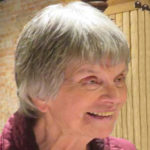By Carol Buchanan, PhD
In 1962, the first graduate school class at the University of Kansas required of English majors was called “Bibliography and Methods of Literary Research.”
Literary research in that class meant historical research.
The professor gave each of us a name from the eighteenth or nineteenth centuries and told us to compile a bibliography of everything we could learn about that person. Even now, I remember the name I got: Richard Watson Dixon. Finding out about him meant rooting around in card catalogs and book stacks that descended five steep, spooky floors below the KU library. It meant waiting for Interlibrary Loan, for permission to get access to old records, and squinting at microfiche documents – when I could get on a machine.
When I Googled that name recently, I learned in a matter of seconds far more than I remembered about Canon Dixon, or wanted to know – then or now.
Yet the skills I learned in that antique class have stayed with me through all the changes in research methods brought about by the personal computer which made Sir timothy Berners-Lee’s invention of the Internet (1989). For the last 25 years, I’ve used these skills intensively to write historical fiction and narrative history.
I’ve written four historical novels set in early Montana history, and am writing a fifth. And I publish a free newsletter and teach a (noncredit) class at our community college, both titled “Becoming Montana.”
In 1997, when I began to research early Montana history, I had to use a combination of old and new methods. Living within reach of the University of Washington library, I once again traipsed up and down stairways (thankfully above ground) to the rare books room to read historical documents. I took notes in pencil because pens weren’t allowed, and I read fast because documents and books could not be removed.
Slow as that was, I relearned one fact of research: A question answered always leads to more questions.
When a question arose in the ACFW critique group about how fast or long a horse could run, I began to investigate. About the same time, I read in Stephen E. Ambrose’s Undaunted Courage that in 1801, no human being had ever traveled faster than a horse could run. All transportation on land was either by horse, mule, ox, or on foot.
How fast was that? How long could a horse sustain what speed?
Questions of transportation are vital in portraying the environment of my novels. So, I set out to learn how fast horses could run, how far, and for how long. I asked other horse people and equine veterinarians. The answer: “It depends.”
Then the Internet took off.
Old documents came out of rare books rooms and onto the Internet. Books I couldn’t remove in 1997 now reside on digital form on my hard drive. I read a man’s account of fleeing armed robbers in 1863 for more than a hundred miles through two feet of snow. The horse carried the man to safety, but he was never again sound. His owner put him out to pasture for the rest of his life.
I doubted that story, so I set out to verify it.
Then a friend told me she was going to ride in the Tevis Cup, one of the oldest and toughest endurance rides in the United States. The race course crosses the Sierra Nevada mountain range in northern California and must be completed in 24 hours. Equine veterinarians and rest stops for horse and rider are posted at intervals along the way to check the condition of the participants, both horses and riders. Especially the horses.
The horse that saved his rider in 1863 crossed the Continental Divide (at one of its lowest points, in SW Montana) and did the equivalent of the Tevis Cup and more.
I now believe the man’s story.
Research is vital for every writer, and the more I seek, the more I find.
 Carol Buchanan, PhD, writes historical Westerns set in the Montana gold rush when ruffians ruled and murder was tolerated. Awarded Spur and Spur Finalist from the Western Writers of America, and the “Spirit of Dorothy Johnson” from the Whitefish Library Association, she teaches “Becoming Montana,” a class in early Montana history at Flathead Valley Community College. She is married to Sir Richard, her “tech support.” Her website is https://carol-buchanan.com.
Carol Buchanan, PhD, writes historical Westerns set in the Montana gold rush when ruffians ruled and murder was tolerated. Awarded Spur and Spur Finalist from the Western Writers of America, and the “Spirit of Dorothy Johnson” from the Whitefish Library Association, she teaches “Becoming Montana,” a class in early Montana history at Flathead Valley Community College. She is married to Sir Richard, her “tech support.” Her website is https://carol-buchanan.com.
